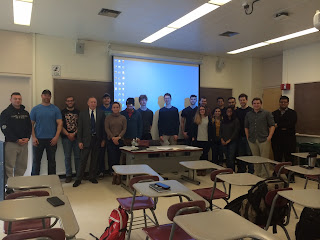Mr. Rust has 11 years of experience at Cooley Dickinson Hospital and previously also worked in the police department and at Smith College.
Mr. Rust's guest lecture was fascinating and provided us with a wealth of information on emergency preparedness in the very important hospital healthcare setting.
At the beginning of his lecture, Mr. Rust told us that hospital emergency preparedness lies somewhere between preparing for emergencies and preparing for disasters since every day a hospital is involved in life or death decisions. He noted that it is important to identify: What are we preparing for? since preparing for anything, anytime, is much too general.
He noted that the hospital prepares for "any incident that has the potential to have a negative effect on normal operations of the hospital." The Joint Commission is the regulatory body that also accredits hospitals and it emphasizes communications, resource and asset management, the importance of the functioning of utilities (he mentioned the huge impact that a water main break would have on hospital operations, for example), as well as patient clinical support. Events, originating with 9/11, and including natural disasters such as Hurricane Katrina, have stimulated the growth in and emphasis of hospital/healthcare emergency preparedness. I was delighted that he mentioned so many issues and events that we had been talking about in the course so far (and even had other guest speakers on) from the Ebola outbreak in western Africa (that Cooley Dickinson even prepared for and learned lessons from) to the Boston Marathon bombing.
He also spoke about the ASPR (Assistant Secretary for Preparedness and Response) and that hospitals have realized that one needs a system-wide perspective, even if hospitals, which are non-profits, compete with one another for patients, since although they are non-profits, they are still businesses. Means of cooperation include: fatality management, information sharing, dealing with medical surges, and even volunteer management, along with emergency operations coordination. Cooley Dickinson Hospital is part of a health and medical coordinating coalition. Members include hospitals, public health facilities, long-term care facilities, community health centers, and EMSs. He also emphasized - as several of the guest lecturers this semester have - that relationships between these various entities have to be built before emergencies and disasters occur. Despite numerous documents and plans, when an emergency happens, the training and experience kick in, and no time should be wasted in response.
Mr. Rust also reinforced the importance of practice drills and mentioned a recent exercise that his hospital was involved in which simulated a norovirus outbreak post a wedding with twenty patents arriving in the emergency room in twenty minutes. He also spoke on the scheduling of hospital staff, and the replenishment of supplies and medicines, and the fact that older hospitals do not have much (if any) space for warehousing. He talked about the maximization of existing resources (great reference to operations research) and the strengthening of community health resources and emphasized that it is humans that play the most important roles.
In speaking about the different regulations (and associated organizations) he mentioned CMS (Center for Medical Services) and how it identified such key essentials in hospital emergency preparedness as: safeguarding human resources, maintaining business continuity, and protecting physical resources. A hospital is supposed to be operational and self-sufficient for 72 hours following a disaster. Towards that end, he noted how Cooley Dickinson has alternative fuel sources and also mentioned how generators on low levels of healthcare institutions flooded both during Hurricane Katrina as well as Superstorm Sandy (something I had also mentioned to the class).
One of my favorite takeaways and quotes from today's fabulous lecture, during which I took copious notes, was that "hospitals are a team sport."
He spoke about the hospital incident command center and how incident command centers evolved from battling fires (I had shown the students a video of the response to San Diego's fires of a while ago which illustrated precisely such an incident response system, so the analogy, although not perfect, was great for the students to hear).
More precisely, what are the challenges for hospital emergency preparedness (EP)? Mr. Rust identified the following challenges, reminding us, again, that hospitals are non-profits:
- hospitals compete with other hospitals
- EP can be complex and confusing
- it is costly to stock supplies and equipment that may be needed in emergencies
- it is labor-intensive to prepare
- there is a low probability of high-impact large events
- "apathy" - it won't happen here
- defining triggers - when does it become an emergency, given that hospitals are involved in life or death decisions each and every day
- "storm of century" media hype.
After the class and so many very interesting questions from the students, we took the group photo below.
We are truly grateful to Mr. Brian Rust for taking the time out of his very busy professional schedule to share his very valuable insights and expertise on hospital emergency preparedness with us. This is a guest lecture that we will never forget. He was an amazing Professor for a Day at the Isenberg School!






















